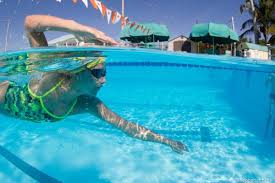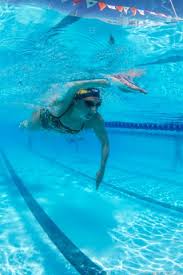Welcome back to our NEW series on Freestyle Flipturns! In our new 3-part series, we will be breaking down the Freestyle Flipturn into 3 main segments: the approach, the flip, and the push-off. Each post will build on top of the last to help your swimmer’s improve their Freestyle Flipturns!
Let’s get started…
If you think about a 500-yard freestyle, a swimmer must complete 19turns. During those 19 turns, it takes an elite swimmer somewhere between 5-7 seconds to complete a turn (from flags to flag—completing 10 yards total). Within those 5-7 seconds, only about ~1 second of it is devoted to the “flip” itself. That’s why it’s extremely important for swimmers to focus on their approach AND their push-offs from the wall–to really maximize their velocity and minimize their time from their turns.
To have a great approach a swimmer must do 3 things:
1.) Anticipate the Wall
Just like in Backstroke, you should know your ideal (Freestyle) stroke count into the wall. Keep in mind: This stroke count will change depending on your speed and race distance, so you should have a few different stroke counts.
By knowing your stroke counts, it will help you setup for more consistent turns and you will be more actively focused and prepared for your upcoming transitions.
The swimmer in the photo below is anticipating her turn, but she is unsure of her distance away from the wall causing her to look up before the turn! By knowing your stroke count, you avoid having to lift the head and see how far you are away from the wall!

WITH A CONSISTENT STROKE COUNT, IT WILL TAKE AWAY THE NEED FOR A SWIMMER TO LOOK “UP” TOWARDS THE CROSS.
2.) Look for the “T”
There is one other marking on the pool floor that will help a swimmer anticipate their flipturn and that’s the “T” at the bottom. As a swimmer is approaching the wall, it is advantageous for them to not only count their strokes, but look for the “T” at the bottom of the pool.
By looking for the “T”, it will keep the swimmer’s head low, give them another way to anticipate the wall, minimize their drag, and maximize their speed before their flip.
The swimmer in the photo below is looking straight up at the cross on the wall. This head positioning is causing her feet to sink, and her speed to significantly slow down.

BY LOOKING FOR THE “T”, IT KEEPS THE SWIMMERS EYES FOCUSING AT THE BOTTOM OF THE POOL–WHICH MINIMIZES FRONTAL DRAG AND MAXIMIZES SPEED.
3.) Drop their Chin
As a swimmer finishes their last Freestyle recovery stroke, he or she should start tucking their chins and dropping the crown of their head towards the bottom. By dropping the chin, the swimmer will carrying their speed further into the wall by keeping the swimmer in a tighter ball.
As you can see from the swimmer below, she has dropped her head under the water–but there’s a significant amount of space between her chin and chest. This space will cause her somersault to be slower than it needs to be.

BY DROPPING YOUR CHIN DOWN, IT WILL HELP TIGHTEN YOUR SOMERSAULT AND CARRYING YOUR SPEED FURTHER THROUGH THE TURN!
If you are a coach–be sure to watch for an extra head lift from your swimmer’s right before their turns. If you notice even the slightest increase in visibility of their cap, there is a 99% chance the swimmer is looking up towards the wall.
If you are unsure whether a swimmer is looking up, get their flipturns analyzed with one of our video analysis packages. Here at Swim Like A. Fish, we offer 4 different packages of video analyses to help maximize our coach’s hours in their day.
[CLICK HERE] for Part II, where we will discuss the somersault itself.
-Abbie Fish

5 Responses
Excellent